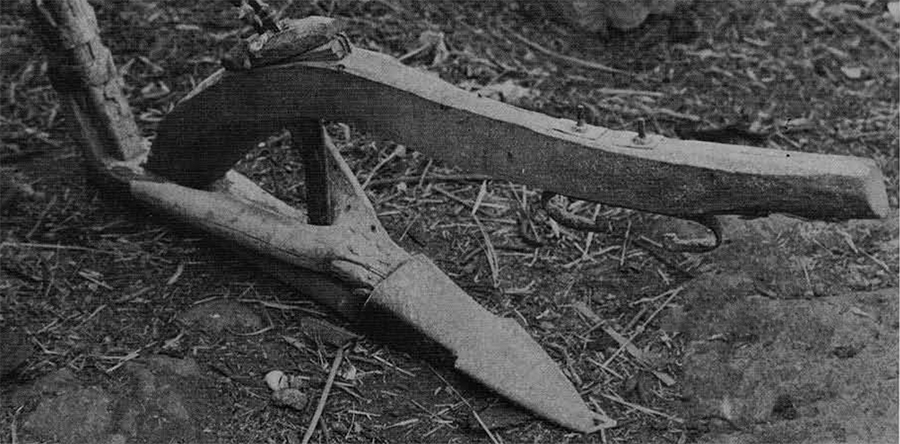
Despite occasional pronouncements to the contrary, soil and climate seem to be two of the most changeless aspects of continuity from the Greece of the ancients to the Greece of the twentieth century. These two factors are fundamental in determining the agricultural practices of the region, A discussion of cultivation techniques is therefore necessary for understanding some of the basics of Greek agriculture in all periods. This is particularly important in view of the fact that the soil-working technology of the Mediterranean lands differs in a number of ways from that familiar to people from temperate climates.
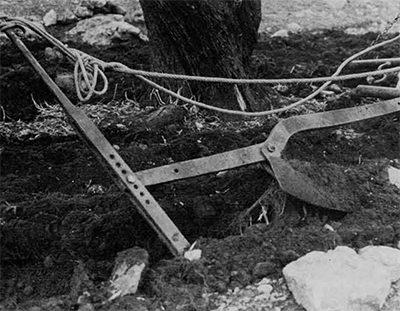
The differences between Mediterranan and temperate European soil-working technology were brought home to me during two years of fieldwork spent on the small volcanic peninsula of Methana, situated in the Saronic Gulf, about two and a half hours’ boat journey from Athens. I am taking the Methana situation as fairly representative of the climate of lowland southern Greece as a whole. Though Methana is perhaps slightly warmer and drier than a number of areas in southern Greece, the differences are so minor that they do not affect the more basic aspects of agricultural technology.
The climate of lowland southern Greece is known as a true Mediterranean climate. The summers are hot and dry, and little, if any, rain falls during the period from May through September. Winters are cool and rainy. In two years of weather recordings made on Methana, only three frosts were measured, In southern Greece the presence or absence of water is therefore a more critical factor for crop growth than temperature. This is in contrast to countries in the temperate zone, such as Britain, where rainfall is more evenly distributed throughout the year and where cold temperatures halt plant growth during the winter months. Colder spells during the winter in southern Greece may slow plant growth, but they do not completely stop it. For this reason, the basic arable crops are sown in the autumn, once the first rains have thoroughly dampened the soil. This usually occurs during the latter part of October, but may not take place until November or even December if the rains are late. The crops then develop through the winter and spring, and are harvested in late May or June.
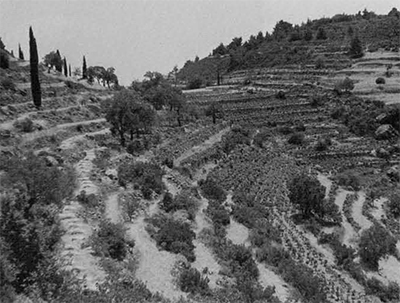
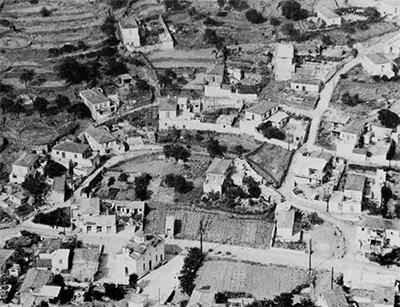
Although it has been said that winter is the rainy season, rain is not particularly abundant even at this time. This fact, and the almost complete lack of rain during the summer months, which is the growth period for the tree crops and vines, mean that every effort has to be made to retain moisture in the soil. Herein lies one of the main differences between Mediterranean soil-working technology and that of the damper, more temperate climates, where traditionally one of the main aims in working the soil has been to ensure adequate drainage so that excess water can escape.
The different aims of cultivation in the Mediterranean and temperate zones are brought out in the different types of plough used in each area. The mould-board plough, which turns over a furrow, burying the sod, is the typical plough for the damp soils of the temperate zone, and has been used there since at least the mediaeval period. The traditional plough of the Mediterranean lands has been used since prehistoric times, It is the light ard, or scratch plough. Unlike the mould-board plough, this tool merely breaks up the soil without turning it over. Modern Greek ploughs are fitted with “ground-wrests” which break up a wider strip of soil than would otherwise be possible. Such a development would seem to be at least as old as the Roman period, if we are to believe the description of a plough with “ears” given in Book 1 verses 169-175 of the Georgics of the Roman poet Vergil.
The degree of sophistication in soil-working technology reached by the villagers of Methana can perhaps best be seen in their method of growing vegetables completely without irrigation during the hot, dry summer months. Although this practice is not found everywhere in southern Greece, it is known in a number of localities in the Peloponnesos and in Crete. The crops grown in this way include zucchini and winter squashes, cantaloupe melons and watermelons, green beans, okra, millet and cotton. The sight of all these plants flourishing unirrigated during the height of the Greek summer intrigued me so much that the following spring I persuaded one of the villagers to let me grow unirrigated vegetables on one of his fields, and to instruct me in their cultivation.

Whereas a single ploughing suffices when sowing the cereals, whose main growth period is during the winter and spring, the preparation of the ground for summer vegetables is more laborious. The ground is ploughed, and then the lumps of earth are broken up, using a harrow made from a board on which the farmer stands, or places rocks, for added weight. This is done three times in all, starting in late winter (generally late January, or February) with a final ploughing and harrowing immediately before the sowing of the crop, sometime in mid to late April, depending on the weather. The repeated ploughing and har rowing produces a layer of finely broken soil, four to six inches in depth. The seeds are sown in shallow pits, roughly one pace apart, with a pint or so of water poured into each pit immediately before sowing the seed. When the plants have sprung up, but are still quite small, they are given another pint or so of water so that they will grow large enough to put down roots into the damp subsoil. This is the only watering that the plants receive.
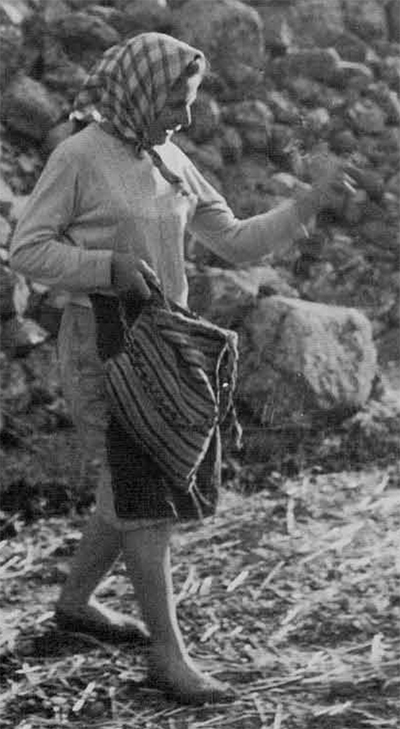
Although the results may be considered remarkable, the explanation of how the system works is quite simple. During the period of winter rains, the subsoil becomes thoroughly soaked. If left unploughed during the summer, the topsoil rapidly becomes dried out and draws up moisture from the subsoil by capillary attraction until eventually the soil is completely dry. The three ploughings and harrowings create a finely broken layer of soil with a great number of minute air pockets. The presence of air pockets means that there are fewer soil particles in contact with each other, thus reducing capillary attraction of subsurface moisture to the surface, where it would soon evaporate. Moreover, the repeated cultivation kills weeds growing in the field: reducing weed growth to a minimum means that there are fewer root systems depleting the soil’s moisture reserves. The top four to six inches of soil rapidly becomes bone dry because the soil is repeatedly churned up and exposed to the air, and because of the large number of air pockets, it cannot draw up moisture from the subsoil. Below this dry top layer the soil remains surprisingly damp. The broken topsoil also more readily admits any rain that should happen to fall during the summer: a hard-packed surface would considerably impede penetration and increase the amount of run-off.
There are thus two factors involved in an effective soil technology for a Mediterranean climate: (a) efficient collection of rainfall—the amount of water lost in run-off must be kept to a minimum; (b) efficient retention of water collected in the soil—the aim here is to reduce evaporation as much as possible and eliminate all inedible weeds which compete for the moisture needed by the crop. A method of serving both ends which has recently received considerable publicity in America, particularly among back-yard gardeners, is “mulching”—that is, covering the soil with organic matter. This helps to reduce run-off at the same time as it minimizes evaporation and discourages weeds. For various reasons, including the relative scarcity of manure and other organic matter, such organic mulching seems impracticable in Mediterranean farming. Instead, the farmers of the region have developed this very efficient alternative method which can justifiably be called “soil mulching.”
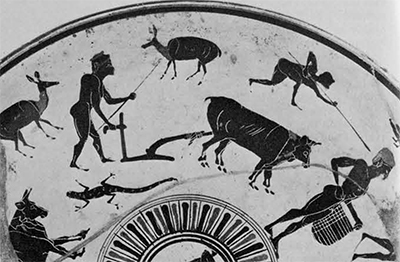
Soil mulching is not restricted to the growing of summer vegetables, however. The villagers also plough below the fruit trees in late winter and early spring, when a noticeable weed growth has developed, and after they have sown the arable crops in the autumn and early winter. Since trees have deep, well-developed root systems, one ploughing is considered sufficient by the farmers of Methana. Cultivation of the vines, on the other hand, is more time consuming. The first stage in cultivating the vines generally occurs in March. This entails digging out the soil from between the rows of vines with a wide-bladed hoe, and piling it up in ridges along the bases of the vines. This process helps to pulverize the soil, to kill the weeds and, by increasing the surface area exposed to the sun, it allows the ground to warm up more rapidly. Later on, in May, the ridges are leveled again, killing many of the weeds which managed to survive the first digging, further breaking up the topsoil, and reducing the area exposed to the drying effects of the hot, dry summer weather.
Throughout the summer the grapes and other fruits expand and ripen, depending entirely on the moisture retained in the subsoil by the layer of bare, broken soil. The beneficial effect of soil mulching was clearly demonstrated to me when I compared the yields of two adjacent plots of vines of approximately equal size. One owner had carefully dug and later leveled the soil on his plot, while the other had merely ploughed between the vines. The well-tended plot yielded almost twice the amount of grapes as did the poorly tended plot.

In recent years, chemicals have been developed which, the manufacturers claim, will eliminate weeds in vineyards without the necessity for digging, which is a particularly back-breaking task. A number of people on Methana have tried these chemical weedkillers, but have generally found the results to be unsatisfactory, because without digging, the soil does not retain its moisture, and the resulting grape crops have been meager. So at least in viticulture, modern developments have not replaced the old-fashioned hard work entailed in breaking up the soil to reduce loss of moisture.
We have seen briefly how soil and climate affect some of the cultivation practices of the modern Greek villagers on Methana. How do these techniques compare with what we know of cultivation practices in antiquity? In Classical antiquity we find that repeated ploughing of fallow land was recommended: three ploughings seem to have been standard. In most agricultural regimes before the ready availability of chemical fertilizers, a period of fallow or a change of crop has been necessary to allow the land to regain some of its fertility before being resown. The purpose behind the practice of multiple ploughings was apparently to ensure that land lying fallow should absorb and retain as much moisture as possible, thus effectively trapping an extra year’s rainfall for the crops sown in the following year. at the same time as the soil regained its fertility.
The time-consuming work of multiple consuming business. The present-day farmer on Methana runs a family enterprise, depending almost exclusively on family labor. Given the pressure of work and the number of hands available in the family work-force, it is difficult to see how the present-day farmer on Methana could find the time for multiple ploughings of the fallow. We know that in antiquity it was not uncommon for farms to have a slave or two in addition to the members of the family. Their presence in the workforce by itself might permit the time-consuming practice of fallow ploughing.

Finally, is multiple ploughing as time-consuming as we have been assuming? Were there perhaps pay-offs in labor saving at other periods of the year? Repeated ploughing retains soil moisture partly because it eliminates weeds. By killing the weeds before their seeds have had time to develop, the farmer might reduce the amount of weed growth in the following year, when it would compete with his arable crops for soil nutrients and water. In the spring on Methana today, one sees large numbers of women out in the fields weeding the wheat by hand—a long, tiring job. By reducing weed growth during the fallow year, is it possible that some of the labor of weeding the crops may have been eliminated?
Although no immediate answers may be forthcoming to these questions, it is important that we consider the effects of social ploughings of fallow land is not practiced on Methana today. Since the best evidence suggests that we can rule out any but the most minor changes in climate, we must look to changes in technology and society to explain the difference. Unfortunately our knowledge of technology and society as it pertains to agricultural practices in Classical Greece is still not adequate for us to make conclusive statements. At the moment we can merely suggest a number of questions which have to be answered before we can pin-point the causes of the differences between ancient and modern cultivation techniques.
A particularly interesting question con cerns legumes (i,e., peas, beans). When was the regular rotation of legumes with cereals introduced in Greece? On Methana today much land is never Mowed because cereals are rotated with legumes (peas, yellow split peas, broad beans, chick peas, vetch] which benefit the cereals sown in the following year by restoring nitrogen to the soil. Legumes not only complement cereals in the field, but also in the diet. They are high in starch so they provide energy. But more important, they have high percentages of those essential amino-acids which are low in cereals. Since plant protein must have a balance of essential amino-acids before it is usable for humans, use of legumes and cereals together is especially significant. The origins and development of the regular use of legumes in ancient Greek agriculture would seem to be an important area for further research.

Another question concerns the interrelationships of agriculture and stock raising. In many parts of Greece today the fallow land is an important grazing resource not only for sheep and goats, but also for draft animals. If the fallow were ploughed under, an important grazing resource would be lost. Not only that, but animals grazing on the fallow leave their droppings to fertilize the ground. Is it possible that farmers in ancient Greece ploughed up their fallow because far fewer animals were kept and there was thus no reason to leave the fallow unploughed? Sheep and goats provide a number of valuable products: wool and hair, dairy products and meat. It is difficult to imagine that such products were in any less demand then than they are now. But if sheep and goats were common, where did they graze? And what were the relations between agriculturalists and pastoralists? We need to know a great deal more not only about the extent of stock raising in ancient Greece, but also about herding methods.
Can the institution of slavery be linked to the practice of multiple ploughing of the fallow? We have already noted that the multiple ploughing of fallow land was a time organization and social institutions in ancient and modern agricultural practices. These, together with the available technology, can profoundly influence the way in which a particular environment is exploited in order to make a living.
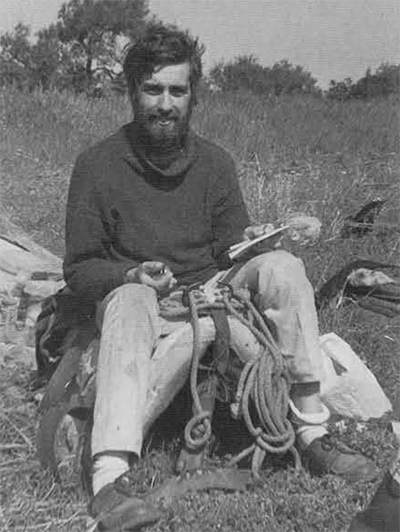
Despite the differences between ancient and modern farming techniques discussed here, many modern writers have stressed numerous aspects of continuity between ancient and modern Greece. The Greek language and the inclusion of originally pagan festivals into the Greek Orthodox calendar are just two examples. Fewer people have given thought to the basic aspects of continuity, such as the necessity of winning a living in a land of generally poor soil and ungenerous rainfall. Although perhaps no longer typical of modern Greece, the Methana farmer of the 1970’s utilizes a range of tools and an agricultural system not much changed from that of his counterpart in Classical Greece. In the last fifty years the Methana farmer has employed mules rather than cattle to draw his plough and he has exchanged his wooden plough for a steel one of almost identical form. But the technology and techniques of cultivation remain largely unchanged. The narrow cultivation terraces on steep rocky slopes make the mechanization of agriculture impossible. Energy is still provided by the farmer, his family, and his draft animals, as it has been in Greece for thousands of years. The hot, dry summers and cool, moist winters still necessitate autumn sowing and a harvest in the early summer. They still demand that the winter’s precious rainfall be carefully husbanded—collected in the soil during the winter and then conserved during the dry summer. More than 2,500 years ago, the Greek poet Hesiod sang “when the Pleiades and Hyades and strong Orion begin to set [i.e., the end of October] remember to plough in season: and so the completed year will fitly pass beneath the earth” (Works and Days 614-17). And so it does for Greek farmers today.
